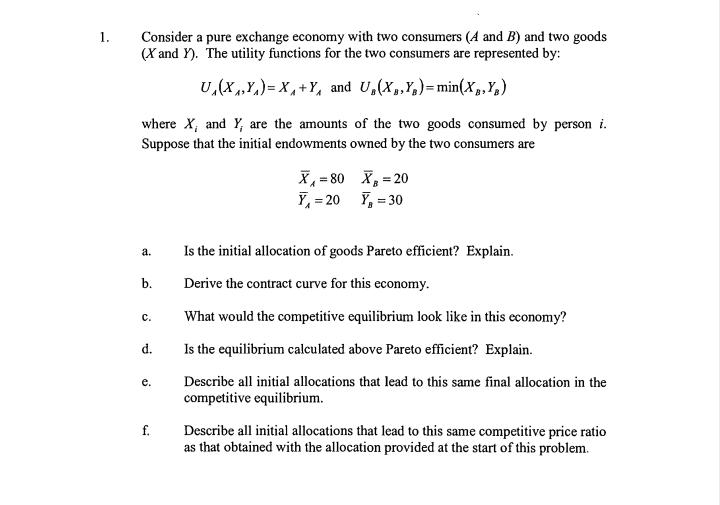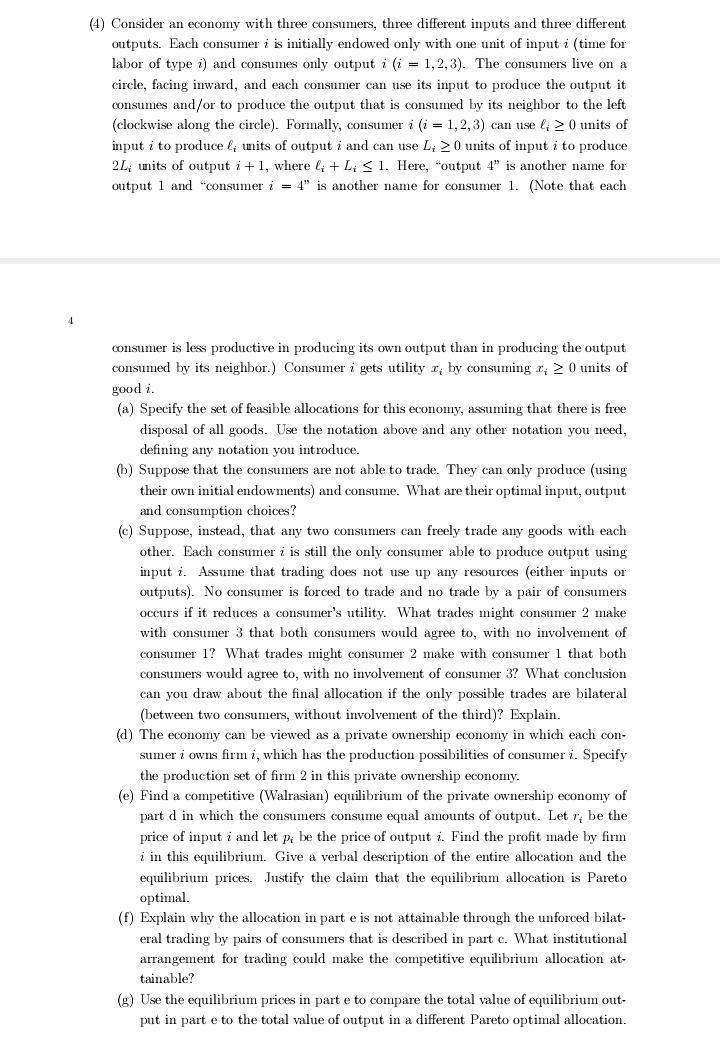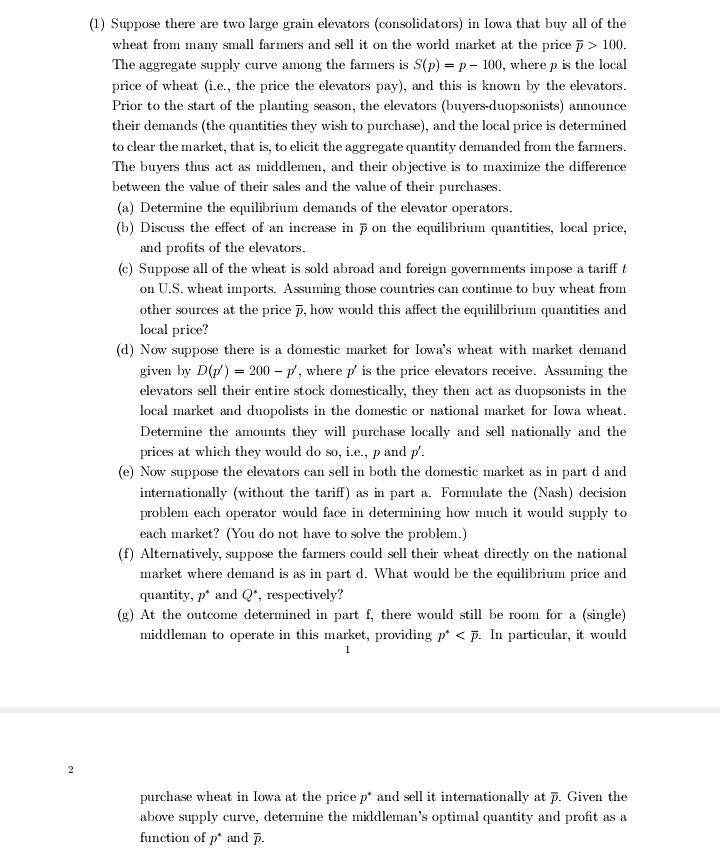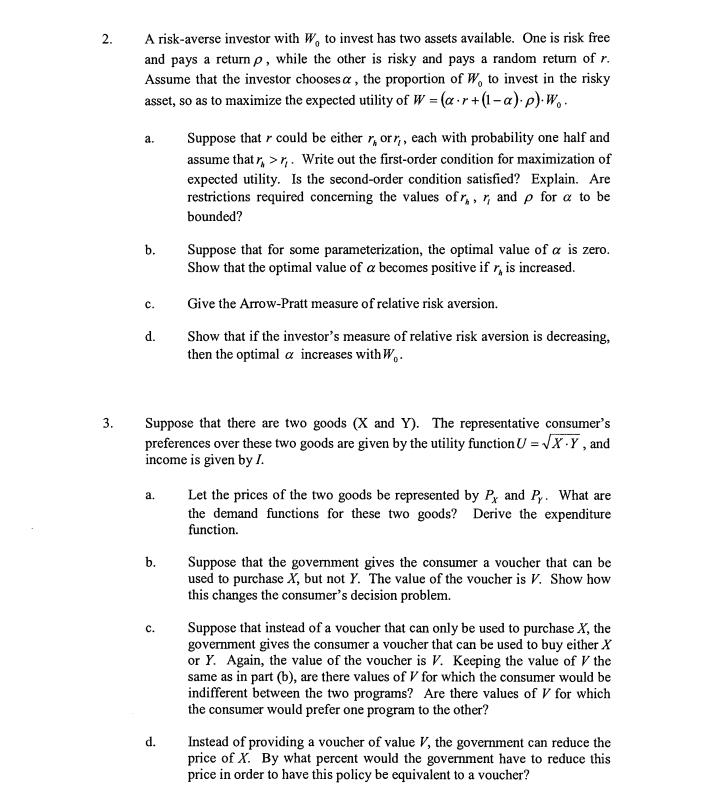



1. Consider a pure exchange economy with two consumers (A and B) and two goods (X and 1). The utility functions for the two consumers are represented by: U,(X,, Y.)= X, +Y, and U,(X,, Y, )= min(X,, Y.) where X and Y, are the amounts of the two goods consumed by person i. Suppose that the initial endowments owned by the two consumers are X, =80 X, = 20 Y = 20 Y, =30 a. Is the initial allocation of goods Pareto efficient? Explain. b. Derive the contract curve for this economy. C. What would the competitive equilibrium look like in this economy? d. Is the equilibrium calculated above Pareto efficient? Explain. e. Describe all initial allocations that lead to this same final allocation in the competitive equilibrium. f. Describe all initial allocations that lead to this same competitive price ratio as that obtained with the allocation provided at the start of this problem.(4) Consider an economy with three consumers, three different inputs and three different outputs. Each consumer i is initially endowed only with one unit of input i (time for labor of type i) and consumes only output i (i = 1, 2,3). The consumers live on a circle, facing inward, and each consumer can use its input to produce the output it consumes and/or to produce the output that is consumed by its neighbor to the left (clockwise along the circle). Formally, consumer i (i = 1,2,3) can use f, 2 0 units of input i to produce f, units of output i and can use L, 2 0 units of input i to produce 24, units of output i + 1, where ( + L, 100. The aggregate supply curve among the farmers is S(p) = p - 100, where p is the local price of wheat (i.e., the price the elevators pay), and this is known by the elevators. Prior to the start of the planting season, the elevators (buyers-duopsonists) announce their demands (the quantities they wish to purchase), and the local price is determined to clear the market, that is, to elicit the aggregate quantity demanded from the farmers. The buyers thus act as middlemen, and their objective is to maximize the difference between the value of their sales and the value of their purchases. (a) Determine the equilibrium demands of the elevator operators. (b) Discuss the effect of an increase in p on the equilibrium quantities, local price, and profits of the elevators. (c) Suppose all of the wheat is sold abroad and foreign governments impose a tariff t on U.S. wheat imports. Assuming those countries can continue to buy wheat from other sources at the price p, how would this affect the equilibrium quantities and local price? (d) Now suppose there is a domestic market for Iowa's wheat with market demand given by D(p') = 200 - p', where p' is the price elevators receive. Assuming the elevators sell their entire stock domestically, they then act as duopsonists in the local market and duopolists in the domestic or national market for Iowa wheat. Determine the amounts they will purchase locally and sell nationally and the prices at which they would do so, i.e., p and p'. (e) Now suppose the elevators can sell in both the domestic market as in part d and internationally (without the tariff) as in part a. Formulate the (Nash) decision problem each operator would face in determining how much it would supply to each market? (You do not have to solve the problem.) (f) Alternatively, suppose the farmers could sell their wheat directly on the national market where demand is as in part d. What would be the equilibrium price and quantity, p' and Q*, respectively? (g) At the outcome determined in part f, there would still be room for a (single) middleman to operate in this market, providing p* r . Write out the first-order condition for maximization of expected utility. Is the second-order condition satisfied? Explain. Are restrictions required concerning the values off, , r, and p for a to be bounded? b. Suppose that for some parameterization, the optimal value of a is zero. Show that the optimal value of a becomes positive if r, is increased. C. Give the Arrow-Pratt measure of relative risk aversion. d. Show that if the investor's measure of relative risk aversion is decreasing, then the optimal a increases with W. 3. Suppose that there are two goods (X and Y). The representative consumer's preferences over these two goods are given by the utility function U = VX" .Y , and income is given by I. a. Let the prices of the two goods be represented by Px and P. What are the demand functions for these two goods? Derive the expenditure function. b Suppose that the government gives the consumer a voucher that can be used to purchase X, but not Y. The value of the voucher is V. Show how this changes the consumer's decision problem. C. Suppose that instead of a voucher that can only be used to purchase X, the government gives the consumer a voucher that can be used to buy either X or Y. Again, the value of the voucher is V. Keeping the value of I' the same as in part (b), are there values of ) for which the consumer would be indifferent between the two programs? Are there values of / for which the consumer would prefer one program to the other? d. Instead of providing a voucher of value , the government can reduce the price of X. By what percent would the government have to reduce this price in order to have this policy be equivalent to a voucher?2. A risk-averse investor with W, to invest has two assets available. One is risk free and pays a return p , while the other is risky and pays a random return of r. Assume that the investor chooses a , the proportion of #, to invest in the risky asset, so as to maximize the expected utility of W = (a.r + (1-a) p). W. . a. Suppose that / could be either r, orr , each with probability one half and assume that r, > r . Write out the first-order condition for maximization of expected utility. Is the second-order condition satisfied? Explain. Are restrictions required concerning the values off, , r, and p for a to be bounded? b. Suppose that for some parameterization, the optimal value of a is zero. Show that the optimal value of a becomes positive if r, is increased. C. Give the Arrow-Pratt measure of relative risk aversion. d. Show that if the investor's measure of relative risk aversion is decreasing, then the optimal a increases with W. 3. Suppose that there are two goods (X and Y). The representative consumer's preferences over these two goods are given by the utility function U = VX" .Y , and income is given by I. a. Let the prices of the two goods be represented by Px and P. What are the demand functions for these two goods? Derive the expenditure function. b Suppose that the government gives the consumer a voucher that can be used to purchase X, but not Y. The value of the voucher is V. Show how this changes the consumer's decision problem. C. Suppose that instead of a voucher that can only be used to purchase X, the government gives the consumer a voucher that can be used to buy either X or Y. Again, the value of the voucher is V. Keeping the value of I' the same as in part (b), are there values of ) for which the consumer would be indifferent between the two programs? Are there values of / for which the consumer would prefer one program to the other? d. Instead of providing a voucher of value , the government can reduce the price of X. By what percent would the government have to reduce this price in order to have this policy be equivalent to a voucher














